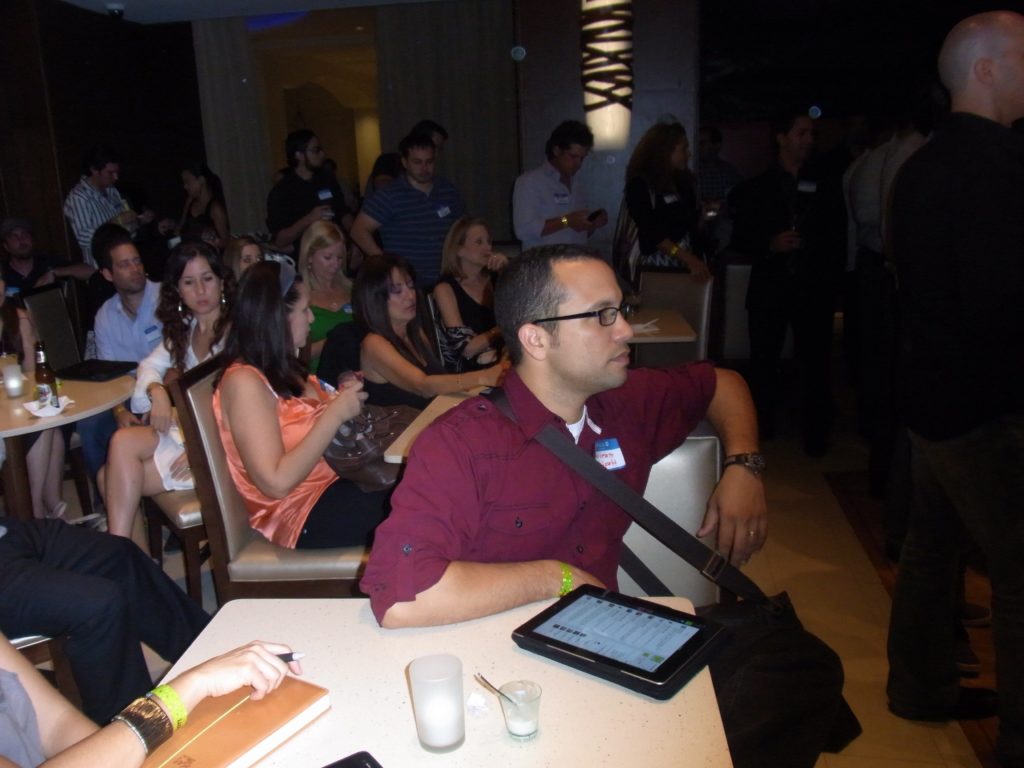Too Much Noise, Not Enough Engagement!
One of the reasons I see many small businesses and entrepreneurs failing is because they don’t have enough healthy relationships or connections. I have seen some cases where we see how someone has an awesome product or service but not many people know about it.
With so many ways to connect many people still fail to get the word out on their current efforts.
Too Much Noise
These new emerging technologies can help you in connecting with others. As with any other resource, if you are just looking for a quick solution to getting your business going and doing too much self-promotion, you end up making lots of noise that can scare away your potential customers.
I see it more times than I would like when people just grab a twitter account, facebook page, or their blog and all they do is create noise. Not only do they miss out on opportunities but can scare away those that might be able to use and promote their services in the future.
I am writing less lately because I have been working on a few projects like helping @mark_hayward build a local 140Conf Community with the goal of setting Puerto Rico as a 140 Conference destination. The other reason I am writing less is to be able to capture your attention when I think I have something relevant to say.
Connect with People
On many occasions I see how the conversation of many individuals will stay at just saying, “Hello.” I see individuals that make their rounds and try to touch base with someone with the key purpose of just mentioning them. I sometimes fall into the same trap that I want to converse with someone and end up just saying hi instead of taking the time in listening to what that person is up too.
For me Google Plus is a better platform for creating conversation. It might be also the type of people who are heavy users of Google Plus go the extra mile in connecting and listening. I have been able to connect in a deeper way with those I have interacted with on Google+.
It all comes down to focusing on quality connections and not the numbers. So many people miss out on getting to know people a lot better because their approach on these platforms is to get lots of followers, friends, likes, to get circled the most, or in the worst of scenarios they just want to push their services and products.
Learn from the True Connectors
I have seen a good mix of people with many followers like @chrisbrogan and @jeffpulver who have reached those numbers because it is natural for them to connect with people. They connect with people to help and share their knowledge. In these cases there is a purpose in doing social good over having large numbers of contacts on these platforms.
I met Chris because he took the opportunity to get to know me better on one of my visits to Boston. Every time I see Chris interacting in real life with people I realize that he truly takes the time to engage with those around him.
The same with @jeffpulver. Jeff takes the time to connect with people and hear what they are saying. They both have a good balance of interacting with big amounts of contacts.
Overall these new technologies are what we make out of them. If you want to have more twitter followers and win a popularity contest go for it (but don’t complain about how the platform did not work out for you).
I rather take the approach of sharing interesting things that might resonate with you. I rather mention how I was amazed at the great work the folks at Seriously Creative are doing and keep you up to date on the newest projects from my friends at Puerto Rico Indie.
What do you get out of these social platforms and emerging technologies?
Any victories you want to share or new projects. I want to hear about them. I want to look for a way that we can all create a virtual business-networking hub.
What do you think? How can we make this happen?




Great post Raul. So glad my buddy, Julio Varela, directed me here. The following are some of the ways I build and strengthen relationships with my audience (as a whole, and as individuals) to increase my Return on Relationship™ (the term I use). P.S. I hope you do not mind this long comment.
1. Listen
If you want to be heard above the growing social media “noise,” you need to first listen to your consumers so when you do speak, you get it right. What are they saying, what are they feeling, what are their pain points, what solutions do they need?
2. Don’t just Listen, but Hear.
ListenThanks to social media, brands can gather vast amounts of valuable information about consumer preferences… but to build relationships you need to go well beyond data gathering and actually hear, and react to what your consumers are sharing. True listening requires a willingness to place consumers’ opinions above the brand’s own (usually biased) view of itself, and to even make product/service changes based on that feedback.
3. Know the People in Your Audience
Short and simple: if you are only focused on the money, you risk completely overlooking the people. Don’t make that mistake! If you don’t know who your people are, you might as well toss your marketing money down the drain.
4. Make it be about THEM
First think about and first address what matters most to your audience. Give them a platform to show you what they need, want, are interested in, and expect. Whatever matters most to them should become what matters most to you!
5. Be consumer oriented (whether that be retail consumers, b to b prospects, or those who consume your personal brand).
We marketers like to think that social media is primarily a set of tools for our marketing purposes, but in reality, social media is also a strong set of tools our consumers use to share and influence opinion about our brand. Our consumers now have “the channel of me.” Consumers’ opinions now create the “reality” of the brand — if enough consumers say negative things about your brand, your brand loses its credibility, and (thankfully) vice versa.
6. Ask “How can I serve you?”
Taking the “ME” mentality one step further, when we are advertising instead of building relationships, we are focused on what our consumers can give us instead of how we can best serve them.
7. Aim for Ongoing Engagement
Your consumers will recognize in a heartbeat if you are simply trying to get something from them – and they will not stick around. It’s not that you aren’t allowed to want anything from your consumers, it’s that there must be a give to go along with every take. If you truly want to make an impact, aim to always put more energy and attention in your “give” column than in your “take” column. It will pay off.Traditional advertising is going for instant impact and hoping and praying you make an impression: splashy billboards, off-the-wall Super Bowl television ads, eye-catching graphics, even shock factor (images of gore, poverty, nudity, animal cruelty, etc.). While those methods are effective in catching a consumer’s attention, they fall short of retainingthat attention. Building relationships is about starting meaningful dialogue and taking the time to thoughtfully and genuinely engage in ongoing conversation. Relationships focus on getting to know your consumer and giving them reasons to stay engaged — not just getting them to react. This needs to be all the time… not simply campaign or initiative based. That is the biggest mistake being made today by marketers and brands… with consumers, and especially with influencers.Brands tend to fall short on this one because real engagement takes time, attention, and overall effort, but I can assure you that working in a vacuum is one of the biggest mistakes a brand can make! A one-time Tweet, a quick Facebook posting, or an email here and there is an announcement, not engagement. Engagement requires a brand to reach out to consumers by asking questions, offering useful content and solutions to relevant consumer issues, providing useful community forums and feedback venues, etc.
8. Authenticity will set your brand apart from the rest in today’s highly competitive market.
True authenticity in marketing requires brands to change their public filters. It used to be that a whitewashed image was the way to get consumers’ notice and buy-in (literally)…but now, if brands filter out any and all slight imperfections, consumers quickly get wary. If the only product/service reviews you allow the public to hear are about how amazing your product/service is, you quickly lose authenticity points.
9. “LESS fabrication, MORE facilitation.
”In other words, don’t waste resources whitewashing your brand. Put your resources instead into giving Advocates the tools to tell their truth about your brand…because that is what consumers trust and what they trust, they will buy. “LESS fabrication, MORE facilitation” = a boost to your ROR.
10. In today’s market, REAL trumps PERFECT because real is what creates TRUST
Give consumers ongoing chances to interact with you and your brand, so they can see that you always tell the truth. Don’t waste your valuable marketing time making things up because your consumers will sense that you are not telling the truth. Do your products and services have all perfect recommendations, as your brand claims? Maybe – but unlikely. 100% on-time delivery? Maybe – but unlikely.Of course you don’t need to announce your errors or be proud of performance inconsistencies, but if consumers bring them up publicly, consider NOT filtering those conversations out of the media. Speak directly to any issues consumers have with your brand, and let your problem-solving conversations be public. These authentic conversations are the ones that build ongoing relationships – the ones that create Brand Advocates.
11. Integrate Customer Service with your social presence.
Use social media for instant and ongoing engagement with your customers. Pay attention to them and address their needs early, often and publicly. Make sure your social team and customer service team are on the same page and communicate regularly and easily.
12. Focus on the relationship before the sale.
When a brand adopts the marketing philosophy that it is all about relationships, they automatically begin paying more attention to the consumer needs and preferences to learn who the consumers really are. Consumers who feel valued by a brand will in turn assign value to the brand by buying the product/service and passing recommendations on to their networks. The sale then becomes a natural part of the ROR instead of a “hard sell” effort.
Relationships ARE the new currency – honor them, invest in them, and start measuring your Return on Relationship™!
Ted,
thanks for the short brief comment at the beginning and sharing the post I had read on a previous occasion on your blog.
In a brief way it is all about working on retaining the attention of people that matter to you and your business. That is the way I see it.
I try to stay away from those Terms I am more in line with the @thebrandbuilder:disqus ‘s way of reasoning how all these acronyms tend to confuse people. ROI is a business metric all other derivations can create confusion when it comes to that. I hope you understand that it is ok to Disagree and I understand your message.
But coming from a Public Accounting and also a military background I try to stay away from the use of Acronyms as much as possible. They become another language for people of a certain industry to communicate with. Thanks for sharing your thoughts.
I find it quite interesting that, at the end of the day, much of this advise is quite practical. It seems to me common sense to operate in this world. Why isn’t it, then? Not quite sure.
Raul,
This blog post spoke to a question I have been mulling over
for the past week (Ok, let’s be honest here, how about I think about it quite
often as I try to reconcile my love for social media with my preference for
in-person interactions). This question is particularly important, as you say, for
small businesses that may not have as many resources as larger corporations. How
/do/ you break through the noise, when it /is/ indeed so overwhelming? Just
this week, I was sharing (ahem, complaining) to a colleague about several small
businesses committing what I have come to call “social media faux pas.” In the
span of a week, I’ve received direct messages on Facebook from two separate small
companies asking people to like their page, have seen a couple of status
updates on Facebook from people requesting Twitter followers. While these may
seem like small problems, together they speak to the larger problem you so
eloquently dissect on your post: it seems like many businesses are concerned
mostly with catching attention/making noise than engaging. I would be interested
to know, does this “Look at me” mentality work for them? Does it truly? Call me
old fashioned, but I honestly believe that the way to make and maintain good
relations online (as in life!) is by genuinely engaging and listening (or like Ted so wisely suggests below, heeearring) to what
others have to say. Time for Miss Manners 2.0?
And yes, I have seen Ted follow all the steps he describes on his comment with much success. I would include him as another example to follow, right up there with Chris and Jeff.
Suset,
I appreciate the time you took to leave this common. I think Miss Manner 2.0 would recommend many same old school protocols which talk about really caring about the other person around.
A good example is someone talking to you online or a company requesting info but never taking the time to read and learn what the most active people are about.
Take the time make a list of 1 person each day who interacts with your business talk to them about what they are interested in. Learn something about one person each day. At the end of the year you end up with a pretty good list of people that you have made a deeper connection.
The main thing is responding and being their to help. Like you said in a comment below some of this is common sense.
At the end like my good friend @chrisbrogan:disqus would say you have to grow bigger ears. Listen more! Does that help?
I think it is even easier to push, poke, and prod people with products and services online than in real life. A lot harder to walk into a room, line up the people and repeat the same sales pitch over and over. And there are people who do this and may get lucky. I think it is easier to read body language and perhaps the intention of the sales person in real life when approached with a sales pitch. A lot harder to gage the intention of all the people using these platforms unless you start conversing with them.
I have made many new friends using these platforms and have had to dismiss those snake oil salespeople who have turned out to be toxic individuals. The funny thing is that on-line their bark is much louder than their bite and in real-life they are what I like to call “FOS” I think after awhile of reading what people write and seeing how they push and don’t engage with you, you can make quicker decisions on what you want to read, who to friend, who to follow, or circle and who you want to delete, uncircle, unfriend, and unfollow. Just my little two cents.
I agree in real life you can get a better sense of the persons intentions.
Having Social Media Snake OIl Salesman repellant is critical.